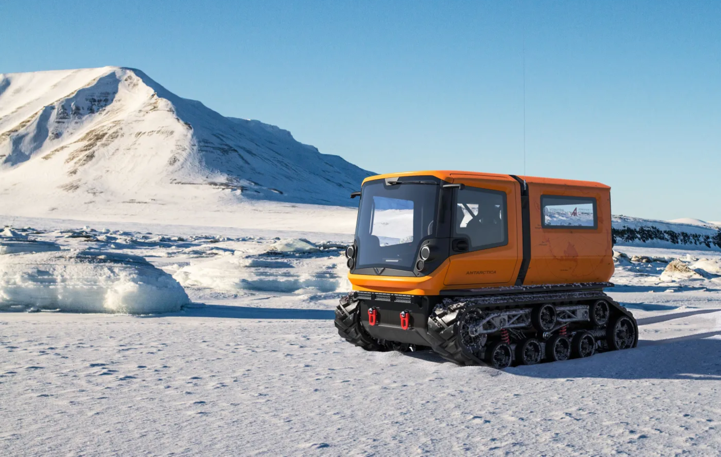H.S.H. Prince Albert II of Monaco and Gildo Pastor © Venturi Chevrin.
A MONEGASQUE STORY
In April 2006, Prince Albert II of Monaco became the very first head of state to reach the North Pole after a gruelling four-day expedition across the frozen wastes of the Arctic. Under extreme climatic conditions, he travelled some one hundred kilometres by dog sled from the Russian drift station Barneo Ice Camp, to the North Pole.
The Prince’s mission was two-fold : to pay tribute to his great-grandfather, Prince Albert I who led four polar exploration missions, including the one that took him to Spitsbergen in 1906, exactly 100 years before the Monegasque expedition. The other important aim of Albert II’s expedition was to raise public awareness of the devastating impact of global warming, especially in the vulnerable polar regions.
After planting the Monegasque and Olympic flags in the frozen ground, Prince Albert II declared : “I’m delighted to have achieved the goal I set myself and to have arrived, safe and sound, with my entire team, at the North Pole. The exceptional human adventure we have just undertaken must not make us forget that our planet is in grave danger, and that we need, more than ever, to take action to safeguard it.”
In 2009, accompanied by the Swiss explorer Mike Horn, Prince Albert reached the South Pole after completing another very difficult journey in harsh conditions. He thus became the world’s only head of state to have visited both poles.
It was upon his return from this particular mission that the Prince decided to launch the first project to put to the test, environmentally-friendly vehicles to replace combustion-powered vehicles and be able to operate in the extreme climates of Antarctica. The development of a zero emission vehicle, able to carry personnel and equipment to and from various polar research stations has been entrusted by the Prince Albert II Foundation to the Monaco-based Venturi electric automotive specialist.
After three successive versions, the next generation of the all-terrain vehicle was presented to the Sovereign on June 1, 2021 at the company’s headquarters by Gildo Pastor, the CEO of Venturi, who declared : “With the Venturi Antarctica, scientists are getting an efficient, easy-to-handle vehicle with very good performance. They will be able to carry out their research in optimum conditions, without polluting sites where the quality of analyses needs to be accurate down to the last molecule. We are proud to have developed a technological solution that fulfils the remit given to us by the Prince Albert II Foundation.”
On 1 June 2021, during his visit to see the next generation Antarctica for the first time, Venturi presented H.S.H Prince Albert II with a gift of the original prototype that he drove in Canada, in March 2019 to navigate part of the 42 kilometre mountainside route between Dease Lake and rsTelegraph Creek, on the lands of the Tahltan people.
The aim of that expedition was to put the machine through a series of tests in climatic conditions similar to those at the South Pole. On Telegraph Creek Road, considered to be one of the world’s most dangerous highways, three drivers climbed aboard Antarctica : H.S.H Prince Albert II of Monaco, the Canadian astronaut Chris Hadfield and the President of Venturi North America, Xavier
Venturi Antarctica, the world’s first zero emission polar research vehicle will be stationed at Belgium’s Princess Elisabeth Research Station in Antarctica on 1 December 2021. Much attention has been paid to the design which, although futuristic, has clean lines.

DESIGN AND TECHNOLOGY
Antarctica’s bodywork was designed by Sacha Lakic, with whom Venturi has worked closely for many years. His vision cleverly sidesteps the technical constraints imposed by the research and development department. Most of these concern the vehicle’s thermal insulation, the size of the battery and the tubular structure of the chassis.
Sacha Lakic has also succeeded in the challenge of developing a design that is both versatile and provides the level of comfort necessary for the passengers. Antarctica is the encapsulation of Venturi’s technological expertise. The Research & Development teams – already working on the Voxan and Venturi world speed records programme – have created a completely unique vehicle, equipped with cutting-edge technological solutions that are both bold and clever.
The vehicle can carry up to six passengers on its fold-down bench seats, including equipment and a second battery that can increase its initial range of 50 kilometres at a top speed of 25 kilometres per hour.
Venturi Antarctica weighs 2 tons and can withstand temperatures as low as -70°C without adverse effects on the battery’s performance. It has opted for two electric motors of 60 kW each, with the possibility of charging from both a power socket and solar panels. Charging times range from 2 to 18 hours, depending on the power source.
To optimise energy management, Venturi is also using parts taken from Formula E, such as the vehicle’s control unit which manages all of Antarctica’s functions, and uses programmes developed in the world of motorsport, particularly for managing power flows.
THE VENTURI GROUP
From its origins as a modest constructor founded in western France in the 1980s, the firm underwent a radical transformation in 2000, after Gildo Pastor bought the business and moved its headquarters to the Principality of Monaco, where he made the strategic choice to focus on electric motors; the pioneering company thus became a world expert in electric mobility and the design and manufacture of high-performance electric vehicles. Whether through world records, expeditions on hostile terrain, the creation of the first electric sports car, the development of innovative vehicles or its involvement in the Formula E World Championship, the Venturi Group embodies and demonstrates all the capabilities of the electric vehicle on 2 or 4 wheels.
Olivier Wenden, Vice-President and Chief Executive of the Prince Albert II Foundation expressed strong admiration for Venturi, following the agreement with the automotive company :“It remains a source of great pride for the Prince Albert II of Monaco Foundation to work alongside intrepid and visionary entrepreneurs like Gildo Pastor, making sustainable innovation not just the core of their R&D, but using it to further the cause of science and preserving our planet. This new Antarctica vehicle is itself a magnificent example of the feats we are capable of, and I am sure it will be a real asset for the scientists at Princess Elisabeth Antarctic Research Station. The polar regions, particularly fragile and vulnerable, must be the focus of all our attentions. They are on the front line of the devastating effects of climate change. To improve our knowledge without disturbing ecosystems, using a zero emissions vehicle capable of withstanding extreme conditions, is a major step forward.”
A series of other thorough tests will be undertaken to verify the efficacy of the insulation and other parameters including the response of the on-board instruments at extreme temperatures. Only then will Antarctica continue its journey to distant lands, and the polar exploration bases that are its ultimate destination.

